Do the Person Know When You Like Their Post on Twitter
At that place are half a dozen forms of appointment and interaction y'all tin can have on Twitter, but the newest is the like. If that sounds odd, given that Facebook likes are the standard for social interaction these days, you're not incorrect. The reason is that Twitter recently changed their Favorite button into a Like button, to better reflect the way people were using information technology.
Rather than just prattle on about likes, I'one thousand going to go over each form of Twitter engagement, and and so come back to the topic of likes and how you can use them.
Tweet Likes
Formerly known equally favorites, Twitter likes are the simplest and however previously most mysterious form of engagement on Twitter. They don't do all that much on their own. Tweets have a like counter, and that counter shows how many people take liked the tweet. In contrast to Facebook, Twitter likes exercise not testify a list of the people who take liked the tweet.
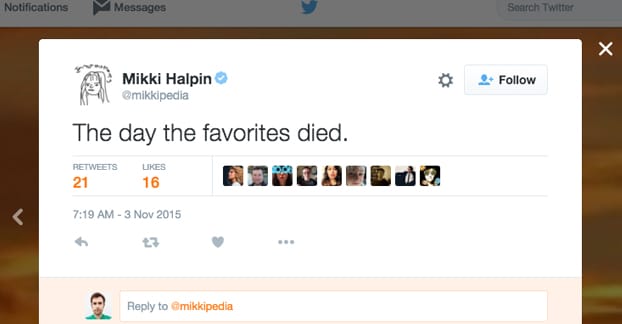
Likes practice a few other things when you like a tweet. For one thing, when you like a tweet, information technology appears in your list of likes. Did you know you lot have a list of likes? It'southward true! If you sign into Twitter and go to your own profile, you lot'll encounter a list of "tabs" up at the acme. These are Tweets, Following, Followers, and Likes. Tweets is the default, and has the sub-tabs of Tweets, Tweets & Replies, and Photos & Videos. The start is your default "filtered" feed of everything you lot've posted publicly. The 2nd is a less filtered version with replies to people – more than on that afterward – and the third is a filter that only shows images and videos you lot've tweeted.
Anyways, if you click on over to the Likes tab, you lot will run across a feed of all of the tweets you have liked or favorited in reverse order. This plays into something I'll discuss later, which is 1 of the possible uses for liking tweets, and ways people employ likes.
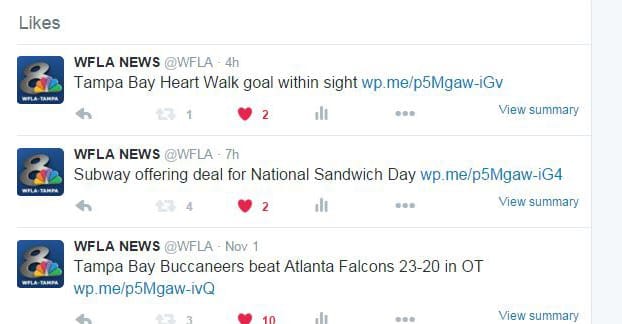
Additionally, of course, when yous similar a tweet, the poster of that tweet is notified. If you similar a retweet, the person who retweeted it will be notified, because you're technically liking the tweet that person made that includes the retweet, not the original tweet itself.
Buzzfeed, of all places, did a study of why people favorite tweets, back when they were called favorites. They also called favorites "one of the most complex and cryptic forms of online communication." That'south a tall guild for what is, essentially, just a thumbs up.
And that'south it.
Reasons People Similar Tweets (And Why You Should Too)
To bring things back to likes specifically, we can think about Buzzfeed's study. They called favorites, what are now likes, mystifying. Different people, information technology turns out, use them for unlike purposes. Some people took the term "favorite" seriously and were very stingy about handing them out. Others, steeped in Facebook culture, used them as a light equivalent to likes.
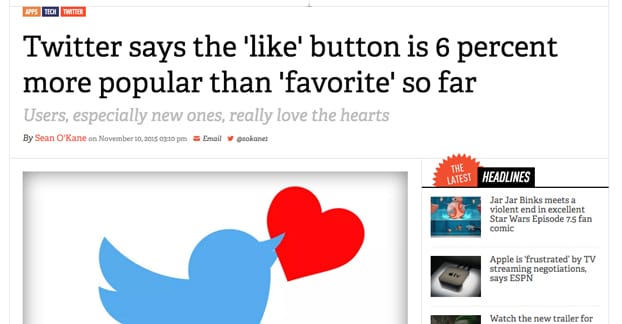
Now that they ARE likes, well, that usage has gotten a lot more popular. Still, permit's wait at the various ways you can use likes.
one: Bookmarking Tweets. I mentioned that you can run into a listing of all of the tweets you've liked at any time, right? Well, that's how some people use it; as a list of entertaining things they tin refer to any time, to re-live memories, refer to item posts subsequently, and more often than not just accept on mitt to reference. I like to utilize it to "bookmark" useful guides for afterwards, also.
two: Expressing Appreciation. This is perhaps the purest form of a like that could be. The Twitter like, in this case, is literally just a argument saying "I liked this mail." There'south goose egg more than to it, and nothing less. Some people utilise the social network literally, later on all. These are probably even the same people who changed how they use the push button when it changed from favorite to like, even though the push functionally didn't change at all.
iii: Showing Acknowledgement. This is, if anything, even less engagement than an expression of appreciation as above. It's goose egg more than a statement saying "I saw this post." Sometimes it's used for one-way messaging; as in, someone @mentions you lot and you like information technology to acknowledge that you saw it, but either don't want to post it to your feed, or don't have anything to say to continue the conversation.
4: Automatic Back up. This is something that brands do, and something that I've written about before. Some brands will set up up bots to monitor sure hashtag uses, keywords, or other Twitter search results, looking for new content. When that content appears, the bot will similar the mail service. Sometimes it does more than, sometimes not; regardless, it'southward an automatic process.
five: Fishing for Follows. Some people employ likes equally a "notice me" poke. They're liking a post from someone in the hopes that the person whose tweet they liked volition go and investigate the account of the person liking their post. The ideal finish result is a common follow, merely that's rarely the actual issue. Almost of the fourth dimension, the liker gets nothing and the likee just accepts the similar and moves on.
six: Passive Aggressive Detest Likes. Surprisingly enough, this happens; when someone is agitated or aroused at someone else, they will like all of the other party'due south posts as a way of proverb "I could say something here merely I won't." Carrie Fisher actually has some interesting examples of this; she will like and retweet insulting posts just as a way to silently sass the affiche, as if to say that the words don't injure her.
7: Non-Verbal Communication. There are a lot of "shy" users on Twitter, who actively monitor their feeds and follow people, but don't post or respond themselves. Some of them just have zippo to add, while others experience equally though they aren't "allowed" to contribute to conversations amid elites or celebrities. Thus, all they exercise is similar.
eight: Flagging for Future Theft. Unfortunately, this happens on occasion. A user will like popular content, just to save that content for later. A week, a month, a twelvemonth down the line, that user reposts the exact aforementioned content without editing, to make it wait as though they are the ones who came up with the content. Unfortunately, there isn't much of any enforcement on the low-key plagiarism going on here.
nine: Personal Engagement. Sometimes, someone will similar your post but non retweet it because, while they personally like the post, they don't call back it fits with their own content plan. They don't want to send your tweet to their audience for fright of losing some of said audience, but they capeesh the tweet still.
10: Affection Expression. Sometimes, when yous like someone, you pay attention to what they have to say and you digitally stalk them to go along tabs on them. Some people religiously similar any post made by their friends, family unit, or crushes, regardless of content. They do it to show back up, to try to go noticed, or just because it lets them feel a connection.
11: Setting a Reminder. Sometimes you run across an interesting post you want to read, only you don't have time on the become. Rather than endeavour to remember the link or lose information technology forever, some people merely like the post. They will then, subsequently, go dorsum to their likes and read the links they had set bated. Remember, you lot tin ever un-like a liked post merely every bit easily as you liked it. There's not even a notification for information technology.
12: Friendly Support. This is similar to the Twitter shell idea, only it's more of a mutually supportive human relationship among friends. I, personally, have many friends who are business owners, some of whom are struggling to proceeds traction. I like to like their posts as a manner to show additional back up, and to "seed" likes and so that people who don't want to be starting time can experience costless to similar the posts as well.
13: Just a Whim. Honestly, some people don't actually know what they're doing, and as a issue, they will but like posts more or less randomly. You tin can likewise throw in drug users hither, people who browse while high or drunk, and don't quite have command over what they're doing at whatsoever given fourth dimension.
14: Showing Sympathy. The sympathy like is a controversial topic. Concluding twelvemonth, Facebook was rumored to be working on a "dislike button" that showed sympathy for negative happenings, but didn't require a postal service. The idea is to make expressions of sympathy easier and less awkward. Of grade, their actual implementation is rather… childish.
xv: Social Aggregation. Sometimes there are people or entities that monitor when tweets in certain niches – like with the hashtag monitoring link higher up – achieve certain thresholds. 1 such is Favstar, which looks for funny posts that attain a certain level of popularity, and then "awards" that user a favstar, simultaneously showing that post to the Favstar follower base. Perhaps they should rebrand, though. I guess LikeStar doesn't have the same ring to it.
16: Contest Entrance. A lot of social media contests, either only on Twitter or using a cross-social entry method like Gleam, require follows/likes/retweets to enter. A lot of people similar a lot of tweets that they don't actually like, just to enter contests and have a chance to win prizes.
17: Consummate Accident. Twitter for mobile has gone through a bunch of redesigns over the years, and sometimes during a design phase, they accept buttons fairly close to one another. It's fairly common for people who aren't precise with their fine motor skills to like tweets they don't actually desire to similar, only considering the buttons are so close together.
eighteen: Brand Reputation Aggregation. Some brands will like whatsoever positive testimonial they receive, then they have one aggregated feed of all the positive press they get. They tin can then use this subsequently, in marketing or but as social proof.
Other Functionality
Twitter has been making a lot of changes (especially Q4 2015). Here is a quick up-to-appointment breakdown of retweets, mentions, and DM's.
Recap 1/4: Tweet Retweets

Retweets on Twitter, in this case, means pressing the bodily retweet button at the bottom of a postal service. When you retweet a tweet, the original poster of that tweet is notified. The tweet is posted to your followers and your feed. It is shown as the original affiche's information, with a pocket-size green "you retweeted" at the top, where "you" is your username.
Some people don't like this form of retweet because it puts someone else'southward profile information in the feeds of their followers. Information technology takes away from them, but realistically that'due south non a bad thing. People tend to dislike feeds that are just "me me me" all the time. People too tend to dislike feeds that are just memes all the time, but that'due south another story entirely.
When yous printing the retweet push, yous are given the opportunity to add a message. If you exercise, that message, posted past you, appears in your feed instead. The tweet you retweeted shows upward below information technology, slightly indented, every bit a smaller version of its former self. This is a more than ideal version of the retweet, and allows you lot to promote others without demoting yourself.
Epitomize 2/4: Tweet Transmission Retweets
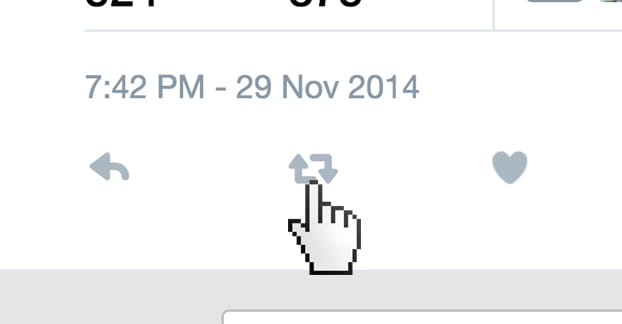
Manual retweets have somewhat fallen out of style amongst some users. Rather than using Twitter'southward retweet functionality, a manual retweet is a copy and paste of the original tweet. You copy and paste the same bulletin, put it in quotes, and add RT: to the front of it. Y'all can likewise add your own commentary or hashtags if yous have the space.
Manual retweets have fallen somewhat out of style simply because Twitter implemented the two-grade retweet button. The ability to add together your ain comment – total length, not just whatever leftover characters remain in a manual RT – meant the manual RT lost virtually of its functionality.
Transmission retweets practise non notify the original poster unless you @mention them as well. Most people will RT @username "original tweet here" (added message). This is fine, but again, a lot of people are starting to prefer the retweet button, both for ease and for space.
Epitomize 3/four: Twitter Mentions
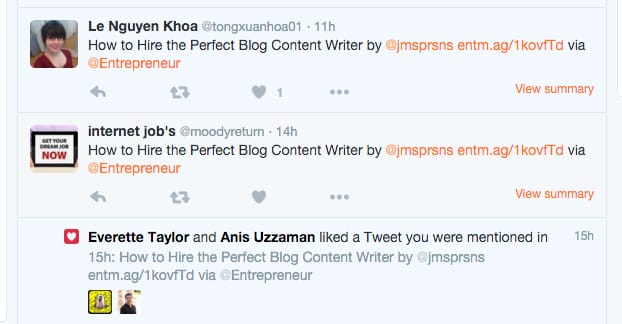
A mention is when you put someone's username in your tweet with the preceding @ symbol. This sends a notification to that user, so y'all can use information technology to gain their attending and talk to them straight, but without using direct messages.
This blazon of engagement comes in two forms; the "individual" and the public. I put private in quotes considering it'south not truly individual, like a direct message. Rather, information technology's just hidden from your public feed. Users can still come across it by clicking on the "tweets & replies" tab in your feed, or by watching the conversation directly in either your feed or that of someone else you lot mentioned.
The only difference between a public and a private mention is whether or not the tweet starts with the @ symbol. If the tweet starts with information technology – that is, the very beginning character is a @ with a username attached – the tweet is a reply. You can reply directly to specific tweets, or you lot tin can reply to a user in general. When replying to specific tweets, people tin see the comment you fabricated by clicking on the tweet and expanding it to encounter replies.
Public mentions just take the @mention in a different space. If you're making a respond to someone and want that reply to be public, the most unremarkably accepted way of doing it is to add together a . before the @. A tweet starting with .@username may count every bit a reply and show upwards in that tweet's feed, but information technology also shows up in your audience feed only as a post you made would.
Recap four/iv: Twitter Directly Letters
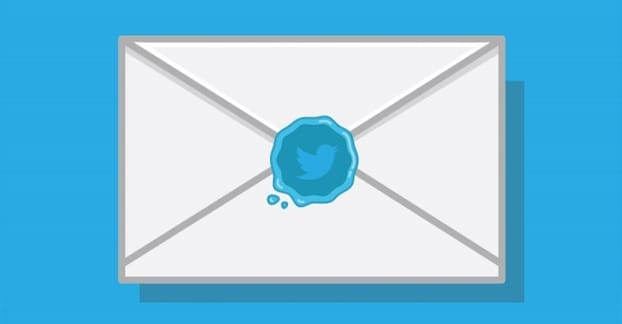
Direct messages interruption all the rules. They are i to one private messages through Twitter as a platform, from i account to another. They don't work the same way equally tweets, and they have a much higher character limit as of just recently. They are most often used every bit private messaging and as direct client support in a private setting.
There's not much more to straight messages. If you've ever used email or whatever web forum with accounts, yous're familiar enough with the concept. If you somehow oasis't, call back of information technology similar Facebook messages, without the live chat interface.
How Do You Use Likes?
Afterward this update, do y'all treat them the aforementioned as favorites, or are you liking more tweets than before? Let us know in the comments below!
Source: https://follows.com/blog/2016/01/tweet-likes-twitter
0 Response to "Do the Person Know When You Like Their Post on Twitter"
Post a Comment